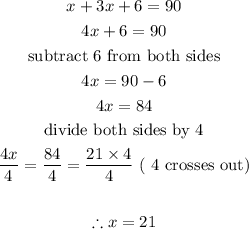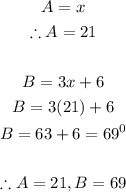The question requires an understanding of what complementary angles are.
Definition:
Complementary angles are angles that add up to 90 degrees.
This means that Angles A and B add up to 90 degrees.
Given that:

It means that we can write the addition of A and B equalling 90 degrees.

Now, let us solve for x. Once we have x, we can find angles A and B.

Now that we have the value of x, we can find A and B. Let us do that now:

Therefore, the final answer is:
A = 21, B= 69